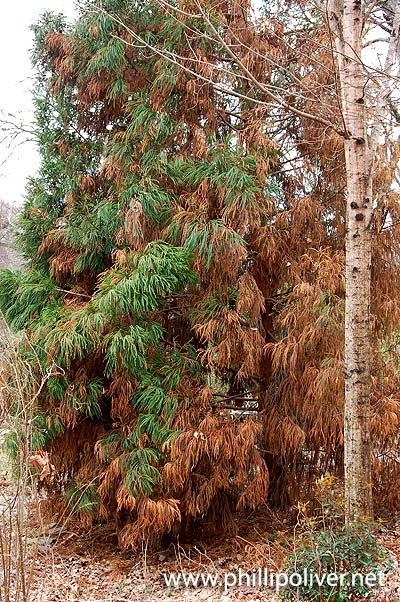Appropriately, the Thanksgiving Cactus
(Schlumbergera truncata) is blooming for Thanksgiving. Not to be confused with the Christmas Cactus (
Schlumbergera x buckleyi) which is easy to do. They are very similar with some minor differences. (And for good measure, there is also an Easter Cactus (
Hatiora gaertneri).
The difference lies in the leaf shape (although to be correct, these are not leaves, they are "stems"). If you look closely at the at the point where two stems meet, you will see that there are pointy segments or "teeth". The Christmas cactus has smooth segments without the pointed teeth.
The Thanksgiving cactus blooms a bit earlier than the Christmas cactus. It typically begins to bloom in November and the Christmas cactus in December. Flowering is triggered by temperature and light changes. When nighttime temps fall between 55 and 60, buds will begin to form. I take my plant outdoors for the summer and bring it inside in September. The change in temperature and the consistency of the indoor temperature triggers the bloom cycle. Sometimes you will get a second bloom cycle around March.
Longer periods of darkness is also needed. If this is a problem where you live, you might place the plant where it can get about 12 hours of complete darkness each night for several weeks.
Once it starts blooming, it is best to leave it in one spot. They do not like environmental changes and will drop the flowers if that happens.
These plants are epiphytes (plants that grow on other plants). Therefore they like regular watering during the entire season. They also like humidity. Well-draining soil is a must. Allow the plants to dry out 2-3 inches from the top between waterings. During the winter months, they enjoy a location with bright indirect light but once they are taken outdoors, a shady or part-sunny location is best. Fertilize lightly once a month during the spring and summer seasons but discontinue in the fall and winter months.
Text and photos by Phillip Oliver, Dirt Therapy






Your plant looks perfectly grown, happy and healthy. It's a beauty.
ReplyDeleteA cactus can be both a cactus and an eipiphyte. The Christmas/Thanksgiving are tropical cactus from areas of high rainfall so it makes sense they are epiphytes because no soil in a wet climate means the drainage is better!
Thanks for the clarification! I will make a note of that. It looks healthy now but it has been through some rough periods. I think I'm going to repot it next spring.
DeleteYour plant looks beautiful! I gave up on mine several years ago - it could tolerate only so much neglect (benign or otherwise) in our dry climate. I've been missing it, though, and the plants in the local garden center have been playing a siren song every time I visit.
ReplyDeleteI am glad you reminded us of the differences between Christmas and Thanksgiving Cactus. I always forget what it is. I love these beautiful little blooms. So cheerful this time of year.
ReplyDeleteI have all 3 cacti, believe it or not! Someone on Gardenweb sent me shoots of a Christmas cactus and I've had it ever since. It's huge now and morphed into 3. I find the Easter cactus to be the hardest to grow because they can't stand being too wet.
ReplyDeleteI leave mine outside on the porch all of the time except for during freezes or when they're blooming. Our heat is only turned up to 67, but they still hate that dry air. Moving them in and out doesn't seem to be a problem as long as I keep a dish of water next to them and spray them with water a couple times a day when they're inside.
Yours looks very happy. It looks beautiful with flowers all over.
Fascinating! I didn't realized there was an Easter cactus too...
ReplyDeleteI found a picture online that compared the 3 leaf patterns: it really helped me visualize the differences. Examining my 2 plants, I now know they are both the Thanksgiving variety. I tucked the non blooming one in the bottom of the closet, maybe I'll get blooms for Christmas.
Fascinating! I didn't realized there was an Easter cactus too...
ReplyDeleteI found a picture online that compared the 3 leaf patterns: it really helped me visualize the differences. Examining my 2 plants, I now know they are both the Thanksgiving variety. I tucked the non blooming one in the bottom of the closet, maybe I'll get blooms for Christmas.